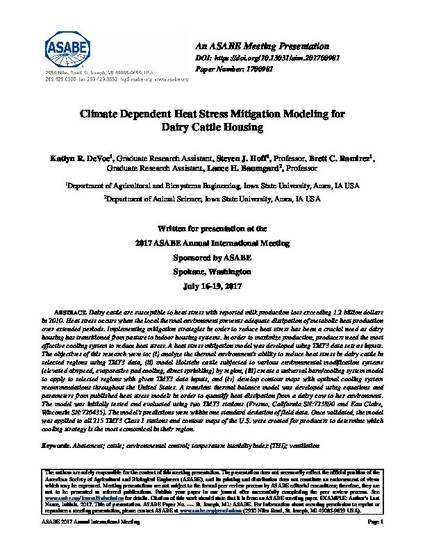
Dairy cattle are susceptible to heat stress with reported milk production loss exceeding 1.2 billion dollars in 2010. Heat stress occurs when the local thermal environment prevents adequate dissipation of metabolic heat production over extended periods. Implementing mitigation strategies in order to reduce heat stress has been a crucial need as dairy housing has transitioned from pasture to indoor housing systems. In order to maximize production, producers need the most effective cooling system to reduce heat stress. A heat stress mitigation model was developed using TMY3 data sets as inputs. The objectives of this research were to: (i) analyze the thermal environment’s ability to reduce heat stress in dairy cattle in selected regions using TMY3 data, (ii) model Holstein cattle subjected to various environmental modification systems (elevated airspeed, evaporative pad cooling, direct sprinkling) by region, (iii) create a universal barn/cooling system model to apply to selected regions with given TMY3 data inputs, and (iv) develop contour maps with optimal cooling system recommendations throughout the United States. A transient thermal balance model was developed using equations and parameters from published heat stress models in order to quantify heat dissipation from a dairy cow to her environment. The model was initially tested and evaluated using two TMY3 stations (Fresno, California SN:723890 and Eau Claire, Wisconsin SN:726435). The model’s predictions were within one standard deviation of field data. Once validated, the model was applied to all 215 TMY3 Class 1 stations and contour maps of the U.S. were created for producers to determine which cooling strategy is the most economical in their region.
Available at: http://works.bepress.com/steven_hoff/153/

This proceeding is published as DeVoe, Katlyn R., Steven J. Hoff, Brett C. Ramirez, and Lance H. Baumgard. "Climate dependent heat stress mitigation modeling for dairy cattle housing." ASABE Annual International Meeting. Spokane, WA, July 16-19, 2017. Paper No.1700981. DOI: 10.13031/aim.201700981. Posted with permission.